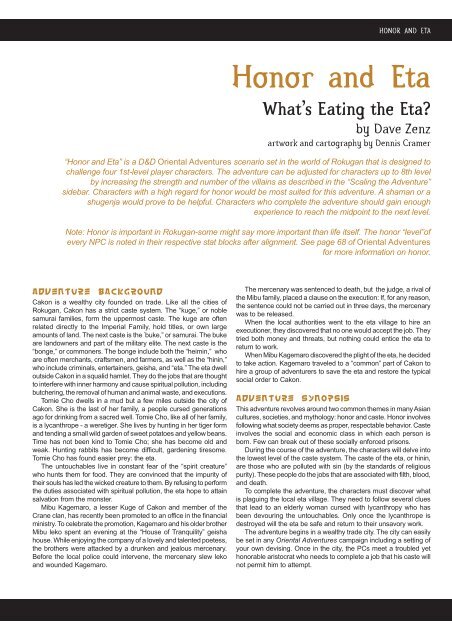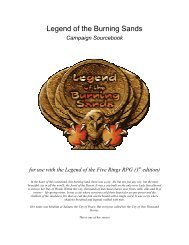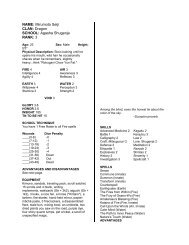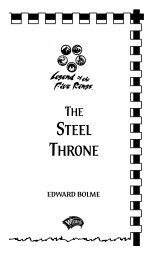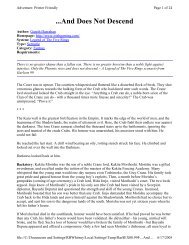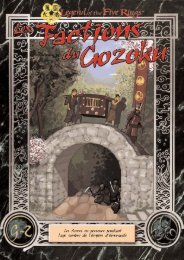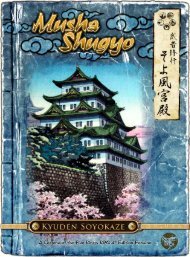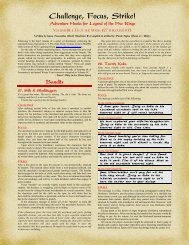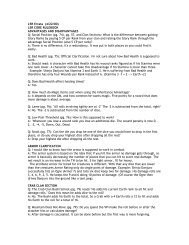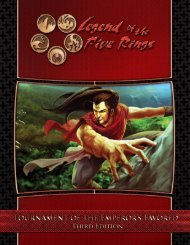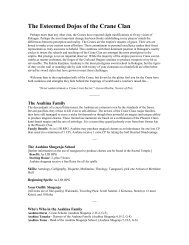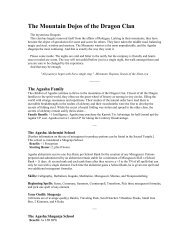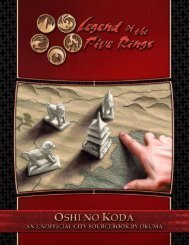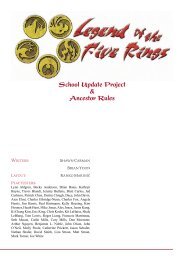Honor and Eta - Kaze no Shiro
Honor and Eta - Kaze no Shiro
Honor and Eta - Kaze no Shiro
Create successful ePaper yourself
Turn your PDF publications into a flip-book with our unique Google optimized e-Paper software.
Adventure Background<br />
Cakon is a wealthy city founded on trade. Like all the cities of<br />
Rokugan, Cakon has a strict caste system. The “kuge,” or <strong>no</strong>ble<br />
samurai families, form the uppermost caste. The kuge are often<br />
related directly to the Imperial Family, hold titles, or own large<br />
amounts of l<strong>and</strong>. The next caste is the “ buke,” or samurai. The buke<br />
are l<strong>and</strong>owners <strong>and</strong> part of the military elite. The next caste is the<br />
“bonge,” or commoners. The bonge include both the “heimin,” who<br />
are often merchants, craftsmen, <strong>and</strong> farmers, as well as the “hinin,”<br />
who include criminals, entertainers, geisha, <strong>and</strong> “eta.” The eta dwell<br />
outside Cakon in a squalid hamlet. They do the jobs that are thought<br />
to interfere with inner harmony <strong>and</strong> cause spiritual pollution, including<br />
butchering, the removal of human <strong>and</strong> animal waste, <strong>and</strong> executions.<br />
Tomie Cho dwells in a mud but a few miles outside the city of<br />
Cakon. She is the last of her family, a people cursed generations<br />
ago for drinking from a sacred well. Tomie Cho, like all of her family,<br />
is a lycanthrope - a weretiger. She lives by hunting in her tiger form<br />
<strong>and</strong> tending a small wild garden of sweet potatoes <strong>and</strong> yellow beans.<br />
Time has <strong>no</strong>t been kind to Tomie Cho; she has become old <strong>and</strong><br />
weak. Hunting rabbits has become difficult, gardening tiresome.<br />
Tomie Cho has found easier prey: the eta.<br />
The untouchables live in constant fear of the “spirit creature”<br />
who hunts them for food. They are convinced that the impurity of<br />
their souls has led the wicked creature to them. By refusing to perform<br />
the duties associated with spiritual pollution, the eta hope to attain<br />
salvation from the monster.<br />
Mibu Kagemaro, a lesser Kuge of Cakon <strong>and</strong> member of the<br />
Crane clan, has recently been promoted to an office in the financial<br />
ministry. To celebrate the promotion, Kagemaro <strong>and</strong> his older brother<br />
Mibu leko spent an evening at the “House of Tranquility” geisha<br />
house. While enjoying the company of a lovely <strong>and</strong> talented poetess,<br />
the brothers were attacked by a drunken <strong>and</strong> jealous mercenary.<br />
Before the local police could intervene, the mercenary slew leko<br />
<strong>and</strong> wounded Kagemaro.<br />
HONOR AND ETA<br />
<strong>Ho<strong>no</strong>r</strong> <strong>and</strong> <strong>Eta</strong><br />
What’s Eating the <strong>Eta</strong>?<br />
by Dave Zenz<br />
artwork <strong>and</strong> cartography by Dennis Cramer<br />
“<strong>Ho<strong>no</strong>r</strong> <strong>and</strong> <strong>Eta</strong>” is a D&D Oriental Adventures scenario set in the world of Rokugan that is designed to<br />
challenge four 1st-level player characters. The adventure can be adjusted for characters up to 8th level<br />
by increasing the strength <strong>and</strong> number of the villains as described in the “Scaling the Adventure”<br />
sidebar. Characters with a high regard for ho<strong>no</strong>r would be most suited for this adventure. A shaman or a<br />
shugenja would prove to be helpful. Characters who complete the adventure should gain e<strong>no</strong>ugh<br />
experience to reach the midpoint to the next level.<br />
Note: <strong>Ho<strong>no</strong>r</strong> is important in Rokugan-some might say more important than life itself. The ho<strong>no</strong>r “level”of<br />
every NPC is <strong>no</strong>ted in their respective stat blocks after alignment. See page 68 of Oriental Adventures<br />
for more information on ho<strong>no</strong>r.<br />
The mercenary was sentenced to death, but the judge, a rival of<br />
the Mibu family, placed a clause on the execution: If, for any reason,<br />
the sentence could <strong>no</strong>t be carried out in three days, the mercenary<br />
was to be released.<br />
When the local authorities went to the eta village to hire an<br />
executioner, they discovered that <strong>no</strong> one would accept the job. They<br />
tried both money <strong>and</strong> threats, but <strong>no</strong>thing could entice the eta to<br />
return to work.<br />
When Mibu Kagemaro discovered the plight of the eta, he decided<br />
to take action. Kagemaro traveled to a “common” part of Cakon to<br />
hire a group of adventurers to save the eta <strong>and</strong> restore the typical<br />
social order to Cakon.<br />
Adventure Sy<strong>no</strong>psis<br />
This adventure revolves around two common themes in many Asian<br />
cultures, societies, <strong>and</strong> mythology: ho<strong>no</strong>r <strong>and</strong> caste. <strong>Ho<strong>no</strong>r</strong> involves<br />
following what society deems as proper, respectable behavior. Caste<br />
involves the social <strong>and</strong> eco<strong>no</strong>mic class in which each person is<br />
born. Few can break out of these socially enforced prisons.<br />
During the course of the adventure, the characters will delve into<br />
the lowest level of the caste system. The caste of the eta, or hinin,<br />
are those who are polluted with sin (by the st<strong>and</strong>ards of religious<br />
purity). These people do the jobs that are associated with filth, blood,<br />
<strong>and</strong> death.<br />
To complete the adventure, the characters must discover what<br />
is plaguing the local eta village. They need to follow several clues<br />
that lead to an elderly woman cursed with lycanthropy who has<br />
been devouring the untouchables. Only once the lycanthrope is<br />
destroyed will the eta be safe <strong>and</strong> return to their unsavory work.<br />
The adventure begins in a wealthy trade city. The city can easily<br />
be set in any Oriental Adventures campaign including a setting of<br />
your own devising. Once in the city, the PCs meet a troubled yet<br />
ho<strong>no</strong>rable aristocrat who needs to complete a job that his caste will<br />
<strong>no</strong>t permit him to attempt.
HONOR AND ETA<br />
Scaling the Adventure<br />
Although this adventure is designed for beginning characters,<br />
the module can be run for characters up to 8th level by changing<br />
the strength <strong>and</strong> number of the opponents.<br />
2nd- to 3rd-level PCs: Run the adventure as written but<br />
with the following changes:<br />
Add one more crow tengu to encounter 4.<br />
Give Tomie Cho a level of wu jen.<br />
4th- to 5th-level PCs: Run the adventure with the changes<br />
above, as well as with the following modifications:<br />
Giving the tengu in encounter 4 maximum hit points.<br />
Increase the number of bakemo<strong>no</strong> in encounter 6 to four<br />
per PC.<br />
Adjust Tomie Cho to reflect the basic weretiger template in<br />
the Monster Manual (<strong>no</strong> age penalties). Also, have Tomie Cho<br />
Character Hooks<br />
The characters can be in the city of Cakon for many reasons.<br />
Some might be native to the region, while others might dwell in<br />
outlying areas. Since the city is founded on trade, the characters<br />
might have journeyed to the location for supplies. Nearby shrines<br />
might have attracted religious PCs. The characters could have<br />
just completed a mission for a patron, instructor, or daimyo <strong>and</strong><br />
are <strong>no</strong>w enjoying some free time.<br />
The motive for the characters to help young Mibu Kagemaro<br />
can be driven by the quest to achieve wealth (the reward Mibu<br />
Kagemaro offers), the aspect of duty (social duty or “gimu”), mercy<br />
for the eta (compassion for others or “ninjo”), or just personal<br />
ho<strong>no</strong>r.<br />
Western characters traveling through the exotic Orient might<br />
also be interested in this mission. Since they are outside the<br />
social structure, the lure of wealth <strong>and</strong> excitement might prove<br />
motive e<strong>no</strong>ugh.<br />
Encounter 1: A Polite Request.<br />
Despite the fact that it is early morning, the temperature <strong>and</strong><br />
humidity have already reached uncomfortable levels. The<br />
market district is full of activity. Swarms of gnats, common<br />
summer pests, hang like clouds over the damp earthen roads.<br />
A trio of bamboo flute playing musicians has captured your<br />
attention. Perhaps it is the common entertainment that attracts<br />
you, or maybe it’s the silk tarp that promises shade <strong>and</strong> a<br />
slight breeze.<br />
While watching the performance, the PCs <strong>no</strong>tice a brightly painted<br />
palanquin carried by two sweat-soaked youths. The palanquin is<br />
brought to the edge of the performance <strong>and</strong> lowered. The screens<br />
are opened <strong>and</strong> a slight, young, thin-lipped, man is visible inside.<br />
The man wears a beautiful pastel orange silk kimo<strong>no</strong>. His hair is<br />
cut <strong>and</strong> oiled in the latest court fashion. A <strong>no</strong>ticeable bruise<br />
darkens the young man’s left eye.<br />
When the musicians have finished, the young man<br />
passionately applauds <strong>and</strong> tosses a h<strong>and</strong>ful of rectangular silver<br />
coins toward the players. He then raises his voice <strong>and</strong> states<br />
that he is looking for a few bold <strong>and</strong> ho<strong>no</strong>rable citizens.<br />
As the musicians depart, a small group gathers about the<br />
palanquin, eager to see more examples of this <strong>no</strong>ble’s wealth.<br />
soak the outside of her but with water to prevent it from easily<br />
burning.<br />
6th- to 7th-level PCs: In addition to the changes above,<br />
add the following modifications:<br />
Increase the number of tengu in encounter 4 to one per<br />
PC, each with two levels as a samurai.<br />
Make the bakemo<strong>no</strong> in encounter 6 hobgoblins <strong>and</strong> double<br />
the number.<br />
Give Tomie Cho three levels of wu jen.<br />
8th-level PCs: In addition to the changes above, add the<br />
following modifications:<br />
Increase the number of tengu in encounter 4 to three per<br />
PC, each with three samurai levels.<br />
Change the bakemo<strong>no</strong> in encounter 6 to ogres.<br />
Give Tomie Cho five levels of wu jen, <strong>and</strong> two ghast allies.<br />
Creature (EL 1): With the slightest bow of his head, the young<br />
<strong>no</strong>ble introduces himself as Mibu Kagemaro, a member of the<br />
financial ministry <strong>and</strong> member of the Crane Clan. He politely<br />
waits for all of those gathered to introduce themselves before he<br />
begins:<br />
“Two nights ago, my brother Mibu leko <strong>and</strong> myself enjoyed<br />
the company of the geisha O-Sode at the House of Tranquility.<br />
O-Sode is a most talented poet <strong>and</strong> the favorite of many<br />
customers. While enjoying the divine company of O-Sode,<br />
we were interrupted by the drunken mercenary Daigoro.<br />
Daigoro was angry that he was unable to enjoy the services<br />
of O-Sode after returning from a hard campaign in the <strong>no</strong>rth.<br />
My brother called out for assistance <strong>and</strong> Daigoro slew him<br />
with a hidden dagger. I, too, was attacked before the doshin<br />
(local police force) could contain Daigoro.<br />
“Daigoro was taken before Judge So<strong>no</strong> Kentanaga <strong>and</strong><br />
sentenced to death. The So<strong>no</strong> have long been rivals with the<br />
Mibu, <strong>and</strong> the Judge placed a clause on Daigoro’s sentence.<br />
If Daigoro’s sentence is <strong>no</strong>t carried out in three days, the<br />
punishment is deemed unfortunate <strong>and</strong> unlucky, <strong>and</strong> Daigoro<br />
is to go free.<br />
“The doshin went to the eta village to hire an executioner<br />
as soon as the sentence was posted. However, <strong>no</strong>ne of the<br />
untouchables would accept the task. Promises of gold coins<br />
<strong>and</strong> threats of death could <strong>no</strong>t convince the eta to complete<br />
the task. The eta said that a man-eating spirit has been ritually<br />
devouring them as punishment for their unclean souls. They<br />
refuse to do any of the duties they <strong>no</strong>rmally perform until the<br />
creature is destroyed.<br />
“If a suitable executioner is <strong>no</strong>t available by sunset today<br />
Daigoro will go free. The death of my brother <strong>and</strong> the attack<br />
on my person crave justice. My loss of ho<strong>no</strong>r would be<br />
unbearable. I come to you at great risk of embarrassment to<br />
myself <strong>and</strong> my family name. I ask you to help me make certain<br />
that Daigoro receives the punishment he deserves.<br />
“A cash string of 30 gold coins awaits any <strong>and</strong> all who accept<br />
this challenge. Upon successful completion of the task, I ask<br />
you to meet me here at dusk. I can<strong>no</strong>t advise you how to<br />
proceed in this endeavor. I only ask that you use good<br />
judgment <strong>and</strong> act independently so as <strong>no</strong>t to further add to<br />
my embarrassment. You have my thanks <strong>and</strong> those of my<br />
ancestors”
With that, Mibu Kagemaro bows his head to the assembled<br />
group <strong>and</strong> closes the palanquin screens. His bearers take him<br />
away from the market district as the crowd slowly dissipates.<br />
Only a few stolid-looking individuals remain.<br />
Mibu Kagemaro avoids contact with the PCs until their mission<br />
is complete. Should the PCs attempt to contact him, he sends a<br />
servant who bears a <strong>no</strong>te that politely requests the PCs act on<br />
their own. He offers <strong>no</strong> further direction or advice.<br />
PCs might want to use the Sense Motive skill to determine<br />
Mibu Kagemaro’s intentions. A successful check (DC 20) reveals<br />
that Mibu Kagemaro has been honest, trustworthy, but<br />
embarrassed by the entire incident.<br />
Mibu Kagemaro, Human Male Ari2: CR 1; Medium-size<br />
Huma<strong>no</strong>id (5 ft. 6 in. tall); HD 2d8; hp 13 (currently 8); Init +0;<br />
Spd 30 ft.; AC 10; Atk +1 melee (1d4/crit 19-20, dagger); AL LN<br />
(<strong>Ho<strong>no</strong>r</strong>able Thought); SV Fort +0, Ref +0, Will +4; Str 10, Dex<br />
10, Con 11, Int 14, Wis 12, Cha 12.<br />
Skills: Craft (calligraphy) +4, Diplomacy +5, K<strong>no</strong>wledge<br />
(geography) +6, K<strong>no</strong>wledge (<strong>no</strong>bility <strong>and</strong> royalty) +6, Listen +5,<br />
Perform (ballad, drama, ode) +4, Profession (scribe) +5, Ride<br />
+4, Sense Motive +5; Feats: Endurance, Skill Focus (Professionscribe).<br />
Possessions: Silk kimo<strong>no</strong>, dagger, calligraphy brush set with<br />
ink <strong>and</strong> parchment, coin purse with 100 gp <strong>and</strong> 30 sp.<br />
Tactics: Mibu Kagemaro will avoid a fight if possible. Although<br />
he has had the basic training in the arts of bushido, he relies<br />
upon his sharp mind <strong>and</strong> status as weapons.<br />
Development: The players might be tempted to have their<br />
characters perform the execution. If this course of action is<br />
suggested, the DM should explain that by undertaking the job of<br />
executioner, the character would attain the same<br />
social stigma associated with the eta. Such a<br />
character would risk loss of all ho<strong>no</strong>r <strong>and</strong> spiritual<br />
pollution - indeed, such a character would <strong>no</strong>t<br />
even be allowed to approach members of the<br />
kuge, such as Mibu Kagemaro. Any other<br />
member of the kuge or buke castes (possibly<br />
including adventuring companions) would<br />
shun the character from the execution<br />
onward, <strong>and</strong> even <strong>no</strong>n-eta bonge would<br />
go out of their way to avoid the character<br />
once news spread of the PC’s deed.<br />
If the characters suggest this to<br />
Kagemaro, he looks at them in disgust,<br />
then pretends he didn’t hear them<br />
correctly. If the PCs press the issue, he<br />
either leaves the area, or, if in his own<br />
“territory,” call for guards to escort the<br />
“would-be eta” from his presence.<br />
Creatures (EL 2 or 4): The characters<br />
might also seek to hire an NPC executioner.<br />
All NPCs they approach turn away with<br />
disgust. A samurai member of the Lion clan<br />
traveling discretely to a rendezvous is in<br />
town, <strong>and</strong> there is a chance the PCs might<br />
try to hire him, as he carries a concealed<br />
katana (Spot, DC 15 to <strong>no</strong>tice it). They also<br />
attract the attention of a member of<br />
Diagoro’s mercenary b<strong>and</strong>, the ronin Tetsuo,<br />
with any inquiries. He then approaches the<br />
PCs, feigning interest in their offer<br />
to find out exactly what they’re<br />
attempting.<br />
HONOR AND ETA<br />
Ogura Tokinari,<br />
Human Male Sam2: CR<br />
2; Medium-size Huma<strong>no</strong>id<br />
(5 ft. 10 in. tall); HD<br />
2d10; hp 16; Init +5 (+4<br />
Improved Init, +1 Dex);<br />
Spd 30 ft.; AC 11; Atk<br />
+4 melee (1d10+1/crit<br />
19-20, katana); AL N<br />
(<strong>Ho<strong>no</strong>r</strong>able Action); SV<br />
Fort +4, Ref +1, Will<br />
+0; Str 12, Dex 12,<br />
Con 11, Int 10, Wis 11,<br />
Cha 13.<br />
Skills: Craft (calligraphy)<br />
+1, Disguise<br />
+1, K<strong>no</strong>wledge (<strong>no</strong>bility<br />
<strong>and</strong> royalty) +1,<br />
Listen +2, Perform +1,<br />
Ride +2, Spot +1.<br />
Feats: Improved<br />
Initiative, Mounted<br />
Combat, Weapon<br />
Focus (katana).<br />
Possessions: Poor<br />
quality kimo<strong>no</strong>, rain cape,<br />
masterwork katana (concealed),<br />
masterwork wakizashi (concealed), straw hat, coin purse<br />
with 20 gold pieces.<br />
Tactics: Ogura Tokanari will be insulted to the point of<br />
violence if asked to perform an execution. He will also<br />
be embarrassed that his disguise has been<br />
exposed. He will challenge the offending<br />
character to a duel unless the party successfully<br />
makes a Diplomacy check (DC 15).<br />
Should combat break out, Tokanari will fight<br />
to first blood before he feels his ho<strong>no</strong>r is<br />
satisfied.<br />
Tetsuo, Human Male Ftr2/Rog2: CR<br />
4; Medium-size Huma<strong>no</strong>id (5 ft. 8 in. tall); HD<br />
2d10 plus 2d6; hp 25; Init +2; Spd 30 ft.; AC<br />
14 (leather armor, +2 Dex); Atk +8 melee<br />
(1d6+3/crit 19-20, wakizashi); SA sneak<br />
attack +1d6; SQ evasion; AL NE<br />
(<strong>Ho<strong>no</strong>r</strong>less); SV Fort +3, Ref +3, Will<br />
+0; Str 17, Dex 14, Con 11, Int 9, Wis<br />
10, Cha 7.<br />
Skills: Appraise +4, Balance +4,<br />
Bluff +4, Climb +6, Disable Device +4,<br />
Disguise +4, Escape Artist +4, Forgery<br />
+2, Listen +2, Ride +2, Swim +4. Feats:<br />
Endurance, Weapon Focus (wakizashi),<br />
Power Attack, Cleave.<br />
Possessions: Cotton kimo<strong>no</strong>, dirty leather<br />
armor, thieves’ tools, masterwork wakizashi,<br />
coin purse with 12 sp.
HONOR AND ETA<br />
Tactics: If Tetsuo is asked about rendering services<br />
as an executioner, he will question the party to<br />
discover the victim. He then laughs at the PCs<br />
<strong>and</strong> plots an ambush. First Tetsuo will use his<br />
Hide skill in a narrow residential alleyway <strong>and</strong><br />
await the PCs’ approach. Tetsuo then<br />
attempts to sneak attack the strongest<br />
looking PC in the tight alley before wading<br />
into combat with the rest of the group.<br />
Tetsuo will fight until he has taken half<br />
damage <strong>and</strong> then try to flee.<br />
Encounter 2: The City Gate<br />
The eta dwell outside the walls of the<br />
city. Eventually the PCs have to leave the<br />
city to speak with them. When they leave<br />
Cakon, read or paraphrase the following:<br />
The gates of the city are open,<br />
inviting in a modest breeze <strong>and</strong> a<br />
constant flow of oxen <strong>and</strong> farmers.<br />
Two guards clad in heavy o-yori<br />
armor, jingasa helmets, <strong>and</strong><br />
clutching spears check the<br />
farmer’s packs for contrab<strong>and</strong>. The<br />
warriors look quite bored <strong>and</strong> seem<br />
to care little about the job they<br />
perform. An old beggar sits in the<br />
shade of the gate <strong>and</strong> extends a<br />
cracked clay bowl toward all who<br />
pass. His skin is tanned dark by the sun <strong>and</strong> his head is<br />
plucked bald. He wears a simple rag loincloth.<br />
Creature (EL 1/3): As the PCs approach the gate, a small<br />
brown <strong>and</strong> white dog slinks out of an alley <strong>and</strong> begins to sniff the<br />
old beggar. As the dog becomes more inquisitive, the beggar<br />
becomes visibly distressed <strong>and</strong> begins to cry out. The dog,<br />
sensing the old man’s fear, begins to growl <strong>and</strong> snap. The guards<br />
<strong>and</strong> a few farmers stop to watch the alarmed old man. Laughter<br />
breaks out when the beggar starts to whimper as the dog tugs<br />
on his tattered clothing.<br />
Stray Dog (Inu): CR 1 / 3 ; Small Animal; HD 1d8+2; hp 6;<br />
Init +3 (Dex); Spd 40 ft.; AC 15 (+1 size, +3 Dex, +1 natural); Atk<br />
+2 melee (1d4+1/ crit 20 bite); SQ scent; AL N; SV Fort +4,<br />
Ref +5, Will +1; Str 13, Dex 17, Con 15, Int 2, Wis 12, Cha 6.<br />
Skills: Listen +5, Spot +5, Swim +5, Wilderness Lore +1/<br />
+8.<br />
Tactics: The dog is just curious <strong>and</strong> only attacks if<br />
cornered.<br />
Creature (EL 5): The old beggar is able<br />
to defend himself but is<br />
currently on a spiritual<br />
journey that m<strong>and</strong>ates<br />
he can<strong>no</strong>t<br />
raise a h<strong>and</strong> to do<br />
so if attacked.<br />
Old Beggar,<br />
Human Male Mnk5: CR 5;<br />
Medium size Huma<strong>no</strong>id (5 ft. 2 in. tall);<br />
HD 5d8; hp 38; Init 0; Spd 40 ft.;<br />
AC 15; Atk +3 melee (1d8,<br />
unarmed attack); SA stunning<br />
attack; SQ evasion, still mind, slow<br />
fall (20 ft.), purity of body; AL LG<br />
(outside the realm of ho<strong>no</strong>r); SV Fort<br />
+4, Ref +8, Will +9; Str 10, Dex 14,<br />
Con 11, Int 10, Wis 17, Cha 8.<br />
Skills: Concentration +6, Escape<br />
Artist +8, Hide +12, Listen<br />
+6, Move Silently +10,<br />
Tumble +7. Feats:<br />
Deflect Arrows, Iron<br />
Will, Lightning Reflexes,<br />
Skill Focus (Hide).<br />
Possessions: Rag<br />
loincloth, begging bowl.<br />
Tactics: The old beggar is an<br />
enigma. He uses his Hide<br />
skill if followed by the PCs<br />
<strong>and</strong> avoids combat at all cost.<br />
Development: If the PCs<br />
even movetoward the dog, it flees. The<br />
guards go back to their duties, <strong>and</strong> the<br />
flow of traffic in <strong>and</strong> out of the city<br />
continues. The old beggar, safe <strong>and</strong><br />
happy, then approaches the PCs<br />
<strong>and</strong> bows.<br />
“Generous citizens, you have<br />
my humble thanks for saving my<br />
unworthy self. I would like to return<br />
the favor by telling you a riddle: ‘Under<br />
the right arm of the strong is the gift. The strong bends to the sky<br />
with two benches of stone at his feet. The gift will guide your<br />
fortune’.” After reciting his riddle, the beggar sits down <strong>and</strong> returns<br />
to his bowl. He will answer <strong>no</strong> questions <strong>no</strong>r speak again to the<br />
PCs. The gate guards explain that he offers this riddle to everyone<br />
<strong>and</strong> is most likely crazy.<br />
If the PC do <strong>no</strong>thing about the stray dog, it runs off after a few<br />
nasty tugs on the old mans rags. The old beggar scrambles to<br />
his feet <strong>and</strong> w<strong>and</strong>ers away muttering<br />
to himself.<br />
Creatures (EL 1): The gate<br />
Kuge guards are lazy, but they<br />
do underst<strong>and</strong> that guarding the<br />
gate is their duty. If asked for<br />
directions to the eta village, they<br />
will look slightly incredulous as to<br />
why the PCs would want to go<br />
there, but they provide the instructions.<br />
The guards then make<br />
quiet, but audible, jokes about the<br />
characters “visiting that sty of<br />
humanity” <strong>and</strong> “wanting to be more<br />
like the pigs” as the PCs walk away.<br />
Gate Guards, Human Male<br />
War1 (2): CR ½; Medium-size<br />
Huma<strong>no</strong>id (5 ft. 9 in. tall); HD 1d8;<br />
hp 11 each (includes +3 hp for<br />
Toughness); Init +0; Spd 20 ft.; AC<br />
14 (+4 brig<strong>and</strong>ine); Atk +1 melee<br />
(1d8/crit x3, shortspear);
AL LN (<strong>Ho<strong>no</strong>r</strong>able Action); SV Fort +2, Ref +0, Will -1; Str 11,<br />
Dex 10, Con 10, Int 10, Wis 9, Cha 10.<br />
Skills: Climb -3, Intimidate +2, Listen +3, Spot +3. Feats:<br />
Alertness, Toughness.<br />
Possessions: Brig<strong>and</strong>ine armor, cotton kimo<strong>no</strong>, shortspear,<br />
bamboo pipe <strong>and</strong> tobacco, coin purse with 9 gold pieces.<br />
Tactics: If trouble erupts, the guards cry out <strong>and</strong> try to hold<br />
the post. Although lazy, they underst<strong>and</strong> that deserting the gate<br />
will cost them their lives.<br />
Encounter 3: The Village of the Untouchables<br />
The eta village lies only a quarter mile outside the city <strong>and</strong> is<br />
visible from the city gate. Read or paraphrase the following as<br />
the characters enter the village:<br />
The village of the eta is little more than a collection of wicker<br />
<strong>and</strong> thatch huts on a barren plain. Garbage <strong>and</strong> filth cover the<br />
muddy ground. The smell is pungent in the warm air <strong>and</strong><br />
catches in your throat. The people who dwell in this squalor<br />
do the jobs associated with spiritual pollution: the removal of<br />
garbage, sweeping of streets, butchering, fish cleaning, leather<br />
work, burying the dead, <strong>and</strong> performing executions. The eta<br />
are despised by nearly all the people of Rokugan, even their<br />
fellow <strong>no</strong>n-eta bonge. A samurai can practice “kirisute-gomen”<br />
<strong>and</strong> cut down an eta on the spot for any imagined insult without<br />
fear of the law.<br />
Currently about 120 eta sit idle. They have built a tiny shrine<br />
in the center of the village <strong>and</strong> adorned it with carved cork<br />
sculptures, bone jewelry, <strong>and</strong> a h<strong>and</strong>ful of copper coins with<br />
square holes in the center (zeni). From time to time, a member<br />
HONOR AND ETA<br />
of the village kneels before the shrine in silent supplication.<br />
The soft sounds of weeping seem to echo throughout the<br />
compound.<br />
PCs are welcome to make a K<strong>no</strong>wledge (religion) check (DC<br />
15) to discover the tradition associated with the shrine. The shrine<br />
appears to be dedicated to all of the local religions. The eta hope<br />
to blanket the divine forces to find salvation.<br />
The eta are shy <strong>and</strong> frightened of visitors. They avoid eye<br />
contact <strong>and</strong> keep physically distant from the PCs. They answer<br />
any questions the PCs ask as best they can.<br />
The eta believe that some spirit creature has developed a<br />
taste for human flesh. The attacks started over a month ago.<br />
The creature attacks at night, once or twice a week. The last<br />
attack was two days ago. The spirit creature prefers children or<br />
the elderly as prey, but all who see the beast die by its claws.<br />
The trail the beast leaves as it drags off its victims is a bloody<br />
mess <strong>and</strong> easy to follow, although <strong>no</strong> one has been brave e<strong>no</strong>ugh<br />
to attempt it. Only one man in the village has seen the creature<br />
<strong>and</strong> lived. Hiro the undertaker encountered the creature four<br />
nights ago while returning from fishing.<br />
If Hiro is requested to come forward, he does so. The man is<br />
a huge, filthy, hairy brute with wild, haunted eyes, a flat face, <strong>and</strong><br />
a toothless mouth. Wounds, only a few days old, decorate this<br />
man’s torso <strong>and</strong> neck. Across his back is a rusted <strong>and</strong> chipped<br />
<strong>no</strong>-dachi (greatsword). Hiro is timid despite his intimidating<br />
appearance. He bows to the ground before the PCs <strong>and</strong> begins<br />
his tale. Hiro states that four nights ago he was returning home<br />
from fishing in one of the channels that water the local rice<br />
paddies about two miles from the eta village. His 8-year-old
HONOR AND ETA<br />
nephew “Oke” was with him. It was dusk <strong>and</strong> they were rushing<br />
home with a small string of fish. Suddenly, out of the underbrush<br />
leapt a huge jungle cat. The creature grabbed Oke <strong>and</strong> shook<br />
him like a rag doll. Hiro plunged his spear into the creature but<br />
the weapon had <strong>no</strong> effect. The creature then turned on Hiro <strong>and</strong><br />
slashed him about the chest <strong>and</strong> neck with its talons. Before<br />
Hiro could attack again, the creature fled, dragging Oke with it.<br />
Hiro returned to the village, ashamed <strong>and</strong> terribly frightened.<br />
Hiro, Human Male Ftr2: CR 2; Medium-size Huma<strong>no</strong>id (6<br />
ft. 2 in. tall); HD 2d10+4; hp 21 (currently 17); Init +1; Spd 30 ft.;<br />
AC 11; Atk +7 melee (2d6+4/crit 19-20, greatsword); AL N<br />
(Untrustworthy); SV Fort +5, Ref +1, Will +0; Str 18, Dex 12, Con<br />
14, Int 10, Wis 10, Cha 7.<br />
Skills: Climb +6, Jump, +6, Profession (undertaker) +2, Swim<br />
+6, Wilderness Lore +2. Feats: Power Attack, Run, Track,<br />
Weapon Focus (greatsword).<br />
Possessions: Rag clothing, straw hat, <strong>no</strong>-dachi, shortspear.<br />
Tactics: Hiro avoids any conflict with the PCs. He k<strong>no</strong>ws his<br />
place in society <strong>and</strong> is careful <strong>no</strong>t to offend those of higher castes.<br />
Hiro also k<strong>no</strong>ws he shouldn’t carry a weapon, but he uses the<br />
<strong>no</strong>-dachi to butcher animals <strong>and</strong> the spear to hunt.<br />
Development: The eta promise to return to work if the attacks<br />
stop. Hiro even volunteers to perform the execution if the party<br />
mentions their overall purpose. The eta will show the PCs a game<br />
trail the spirit creature has used to drag off its latest victims. The<br />
trail leads toward the rice paddies, <strong>and</strong> dried blood can be seen<br />
on the grass. PCs with the Track feat can make a Wilderness<br />
Lore check (DC 10) to identify the signs that a large predatory<br />
feline has passed through the area recently.<br />
The Trail of the Man Eater<br />
The trail the monster leaves is easy to follow. Characters with<br />
the Track feat <strong>no</strong>tice that <strong>no</strong> attempt was made to conceal the<br />
creature’s passage <strong>and</strong> that it uses the same trail frequently.<br />
Like most game trails, the path makes irregular twists <strong>and</strong> turns<br />
but often crosses <strong>and</strong> combines with the footpaths of local<br />
farmers. Droplets of dried blood <strong>and</strong> torn bits of clothing can be<br />
found the entire length of the trail. A successful Wilderness Lore<br />
check (DC 10) allows someone with the Track feat to follow these<br />
signs without trouble for a while. Without the Track feat, a Search<br />
check (DC 10) reveals the signs as well. The surface of the trail<br />
between the scene of Oke’s abduction <strong>and</strong> the beast’s lair doesn’t<br />
change much, so <strong>no</strong> further Wilderness Lore or Search checks<br />
need be made after this.<br />
Encounter 4: The Bridge<br />
At one point the monster’s trail joins with a farmer’s footpath <strong>and</strong><br />
crosses a rather wide irrigation canal. A large tree trunk has fallen<br />
across the canal <strong>and</strong> acts as a bridge. Read or paraphrase the<br />
following as the characters near the bridge:<br />
The trail of the man-eating monster has taken you across the<br />
rice paddies that surround the city. Biting black flies <strong>and</strong><br />
mosquitoes hover over the paddies <strong>and</strong> remain a constant<br />
irritant. The heat has driven the farmers to seek shelter until<br />
evening. The trail of the creature overlaps the farmer’s<br />
foot-paths <strong>and</strong> turns toward a large irrigation canal. The canal<br />
is 15 feet deep with steep muddy sides. The water is brown<br />
with silt <strong>and</strong> moves slowly toward the paddies. An ancient
maple has been placed across the canal to act as a bridge.<br />
The trunk has been worn smooth <strong>and</strong> flat from many years of<br />
use. A few spots of dried blood on the tree trunk bridge indicate<br />
that the monster has used this route to drag off its prey.<br />
Swimming the canal is easy (DC 5); the water is 10 feet deep<br />
<strong>and</strong> moves slowly. Climbing the canal embankments is the difficult<br />
task, as the sides are steep <strong>and</strong> muddy. A Climb check (DC 20)<br />
is required to scale the banks.<br />
Creatures (EL 2): As soon as the characters ready themselves<br />
to cross the bridge, a pair of crow-headed tengu l<strong>and</strong> in the middle<br />
of the bridge <strong>and</strong> draw weapons, seeking to challenge the PCs.<br />
The tengu are small, feathered huma<strong>no</strong>ids with crow-like features<br />
<strong>and</strong> black wings clad in rich red, silk kimo<strong>no</strong>s. Each carries a<br />
katana. The tengu are only interested in a diversion. They don’t<br />
mind injuring or even killing a few humans but are more interested<br />
in making the PCs look foolish The tengu squawk loudly, mimic<br />
the PCs, <strong>and</strong> wave their weapons at the characters, daring them<br />
to cross.<br />
Fighting on the bridge is difficult. A PC struck by a tengu must<br />
make Dexterity or Balance check (DC 10). Failure indicates that<br />
the character has lost her footing <strong>and</strong> plunged into the water.<br />
The tengu do <strong>no</strong>t suffer such restrictions because they can fly.<br />
Crow-headed Tengu (2): CR 1; Medium-size Monstrous<br />
Huma<strong>no</strong>id (4 ft. 6 in. tall); HD 2d8; hp 14, 10; Init +2 (Dex); Spd<br />
30 ft., fly 60 ft.; AC 13 (+2 Dex, +1 Natural); Atk +5 melee (1d10+1/<br />
crit 19-20, katana), -2 melee (1d4+1, beak); SA wing baffle, spelllike<br />
abilities, weapon finesse; SQ sound imitation; AL CN<br />
(Untrustworthy); SV Fort +0, Ref +5, Will +5; Str 12, Dex 15, Con<br />
10, Int 13, Wis 14, Cha 13.<br />
Skills: Diplomacy +6, laijutsu Focus +6, Intimidate +6, Perform<br />
+4, Sense Motive +7, Spot +7. Feats: Dodge, Mobility.<br />
Possessions: Katana, wakizashi, silk kimo<strong>no</strong>s, coin purse with<br />
2d12 gold pieces each.<br />
SA-Wing Baffle (Ex): A tengu uses its wings in melee, <strong>no</strong>t<br />
(usually) to fly, but to buffet <strong>and</strong> disorient its opponents. Each<br />
round, in addition to its <strong>no</strong>rmal attacks, a tengu can make a Bluff<br />
check (opposed by its opponent’s Sense Motive check). If this<br />
check is successful, the tengu’s attack that round gains a +2<br />
circumstance bonus.<br />
SA-Spell-like Abilities: At will: change self, ghost sound, mi<strong>no</strong>r<br />
image, shout. These abilities are as the spells cast by a sorcerer<br />
with as many levels as the tengu has Hit Dice (save DC 11 +<br />
spell level).<br />
SA-Weapon Finesse (Ex). Tengu have the benefit of the<br />
Weapon Finesse feat with the katana, even though this feat can<br />
<strong>no</strong>rmally <strong>no</strong>t be applied to the katana.<br />
SQ-Sound Imitation (Ex): Tengu can mimic any voice or sound<br />
they have heard. Listeners must succeed at a Will save (DC 12)<br />
to detect the ruse.<br />
Tactics: The tengu begin by using their shout spell-like ability<br />
<strong>and</strong> then wading into battle with weapon, beak, <strong>and</strong> wing baffles.<br />
They fight until each takes half damage; they then retreat,<br />
deeming the PCs worthy opponents.<br />
Encounter 5: The Lonely Hill<br />
The bridge leads across the canal to a small, lush meadow. The<br />
monster’s trail continues straight through the meadow near a<br />
single, tall tree <strong>and</strong> two red stones that st<strong>and</strong> near its center, as<br />
evidenced by the occasional bit of torn clothing, flesh, or droplet<br />
HONOR AND ETA<br />
of blood. Read or paraphrase the following as the characters<br />
cross the bridge <strong>and</strong> enter the meadow:<br />
After crossing the ancient maple tree bridge, you <strong>no</strong>tice that<br />
the creature’s trail crosses a grassy meadow. In the center of<br />
the meadow is a single, majestic cedar tree, with two large<br />
red granite stones under its spreading limbs. The scene is<br />
one of great beauty, impossible for even the most talented<br />
l<strong>and</strong>scape artist to capture, <strong>and</strong> obviously all natural in origin.<br />
The monster’s trail, enhanced with a few threads of cloth,<br />
passes near, then turns away from this peaceful scene toward<br />
a small copse of dwarf pines.<br />
This is the answer to the Old Beggar’s riddle. Buried in the<br />
earth at the base of the tree is a small cache of treasure.<br />
Characters can make a Search check (DC 8) to <strong>no</strong>tice that the<br />
ground has been disrupted. R<strong>and</strong>om digging turns up the treasure<br />
in a few minutes.<br />
Treasure: The items are wrapped in an oil-soaked cotton<br />
sheet. The treasure includes two masterwork silver shortspears<br />
(yari) with darkwood shafts, a masterwork silver siangham, a<br />
ceramic flask containing a potion of cure moderate wounds, <strong>and</strong><br />
a rice paper scroll with the following divine spells inscribed upon<br />
it: cure light wounds, doom, magic weapon.<br />
Encounter 6: B<strong>and</strong>its<br />
As you near some dwarf pines on the trail, you hear voices<br />
coming from the small clump of trees, where small misshapen<br />
figures can be seen crouching in the shade. Each of these<br />
small huma<strong>no</strong>ids looks slightly different from his neighbor.<br />
Some are bright blue in coloration, others have tiny horns,<br />
<strong>and</strong> a few have large tusks. The language they mutter is crude<br />
<strong>and</strong> guttural, <strong>and</strong> each of them carries a shortspear. The<br />
creatures appear to be plotting some sort of mischief. Against<br />
a nearby tree are four Medium-size wicker baskets. The trail<br />
you’re currently following does <strong>no</strong>t enter the dwarf pines but<br />
skirts its edge <strong>and</strong> continues along.<br />
The creature’s trail moves near a small clump of dwarf pines.<br />
Lounging about <strong>and</strong> waiting to get e<strong>no</strong>ugh initiative to proceed<br />
with their next attack against pilgrims who travel to a local shrine<br />
is a small troop of bakemo<strong>no</strong> (oriental goblins).<br />
Creatures (EL 3): The characters might be able to surprise<br />
the raiders if they act quickly <strong>and</strong> with stealth. The PCs can each<br />
have a free partial action if they successfully surprise the<br />
bakemo<strong>no</strong>. If the characters remain quiet, they could even avoid<br />
the bakemo<strong>no</strong> altogether <strong>and</strong> sneak past the pines. Read of<br />
paraphrase the following as the party nears the dwarf pines:<br />
Bakemo<strong>no</strong> (6): CR ½; Small Huma<strong>no</strong>id (4 ft. tall); HD 1d8+1<br />
hp 5 each; Init +0; Spd 30 ft.; AC 17 (+1 size, +6 natural); Atk +3<br />
melee (1d8+2, bite), -2 melee (1d6+1, 2 claws); or +0 ranged<br />
(1d6+2, shortspear); AL CE (<strong>Ho<strong>no</strong>r</strong>less); SV Fort +5, Ref +0,<br />
Will +0; Str 14, Dex 10, Con 12, Int 3, Wis 11, Cha 7, Taint 3.<br />
Skills: Listen +4, Spot +2. Feats: Alertness.<br />
Possessions: Bamboo shortspear, coin purse with 2d4 copper<br />
pieces each.<br />
Tactics: Since the bakemo<strong>no</strong> outnumber the PCs, they sense<br />
an easy victory. They fight to the death. These bakemo<strong>no</strong> are<br />
more clever than most <strong>and</strong> attack first by hurling the spears before<br />
closing to melee to claw <strong>and</strong> bite their foes.
HONOR AND ETA<br />
Charm of Perfection<br />
This ornate strip of paper gives its holder a +2 competence<br />
bonus to a skill described on the charm. The paper is inked<br />
carefully with the Craft (calligraphy) skill, usually with a short<br />
poem or fable that deals with the skill in question. The charm<br />
must be carried to provide any benefit.<br />
Caster Level: 5th; Prerequisites: Craft Wondrous Item, Craft<br />
(calligraphy) 5 ranks, skill to be scribed 5 ranks; Market Price:<br />
160 gp; Weight: -.<br />
Treasure: The wicker baskets contain the loot the bakemo<strong>no</strong><br />
have stolen over the past month.<br />
Basket #1: A block <strong>and</strong> tackle, a tiny silver gong (worth 10<br />
gp), four paper lanterns, a piece of uncut jade (worth 100 gp).<br />
Basket #2: A tiny wooden box holding eight fish hooks, a block<br />
of incense, three sunrods, a wool blanket.<br />
Basket #3: A bronze bell, a folding paper fan, 23 sp, a full<br />
helmet with a grotesque ogre mask attachment (kawari kabuto<br />
worth 200 gp), a wooden spoon, a ceramic urn.<br />
Basket #4: A biwa (oriental lute), a set of wooden prayer<br />
beads, a bamboo umbrella, two large radishes<br />
Encounter 7: Crouching Tiger<br />
Eventually the party will find the source of the blood trail: A small<br />
mud but in a tiny hallow. Tomie Cho, the weretiger who dwells<br />
within, is ready for the PCs. She knew her hunting could <strong>no</strong>t go<br />
un<strong>no</strong>ticed forever <strong>and</strong> has planned her attack carefully. Read or<br />
paraphrase the following as the characters enter the weretiger’s<br />
domain:<br />
The trail of the man-eater abruptly ends in a small gravel filled<br />
hallow. In the center of the hallow is a small dome shaped but<br />
made of clay smeared on a frame of bamboo. The outside of<br />
the but has warnings <strong>and</strong> symbols of doom painted upon it<br />
with natural dyes. Before the hut lies a smoldering fire pit.<br />
Bones <strong>and</strong> other charred human remains can be seen amid<br />
the ash in the fire pit.<br />
An old woman emerges from the doorway of the mud hut.<br />
Her long white hair hangs down below her stooped knees.<br />
The old woman’s skin is tanned <strong>and</strong> wrinkled, her eyes cloudy<br />
<strong>and</strong> white. She wears a faded cotton kimo<strong>no</strong>. When she opens<br />
her mouth to speak, you can see that she has few teeth<br />
remaining. “Away with you!” The old woman cries. “Be gone,<br />
you fat, rice-eating fools!” With that, she turns, pushes open<br />
the hide door flap, <strong>and</strong> enters the hut.<br />
Note to the DM: Tomie Cho is a vicious opponent for low-level<br />
characters, even though she is a weaker lycanthrope. Adjust her<br />
strength accordingly if the PCs seem overmatched.<br />
Tomie Cho, Female Weretiger Com1: CR 5; Medium-size/<br />
Large Shapechanger (5 ft. tall human/4 ft. tall, 7 ft. long tiger);<br />
HD 6d8+6; hp 40; AL NE (Untrustworthy); three alternate forms.<br />
Human Form: Init -2; Spd 30 ft.; AC 10; Atk -2 melee (1d3-2<br />
subdual, unarmed); SQ alternate form, tiger empathy; SV Fort<br />
+3, Ref +3, Will +4; Str 7, Dex 7, Con 7, Int 10, Wis 10, Cha 10.<br />
Skills: Craft (basketweaving) +4, H<strong>and</strong>le Animal +4, Listen<br />
+4, Profession (farmer) +6 Search +4, Spot +4. Feats: Endurance,<br />
Improved Control Shape, Skill Focus (Profession - farmer).<br />
Hybrid Form: Init +0; Spd 40 ft.; AC 15; Atk +8 melee (1d8+4,<br />
2 claws), +6 melee (2d6+2, bite); SA pounce, improved grab,<br />
rake 1d8+2, curse of lycanthropy; SQ tiger empathy, scent,<br />
damage reduction 15/silver; Fort +8, Ref +5, Will +4; Str 19, Dex<br />
11, Con 13, Int 10, Wis 10, Cha 10.<br />
Skills: Balance +6, Hide +9, Listen +10, Move Silently +9,<br />
Search +8, Spot +10, Swim +11. Feats: Blind-Fight, Improved<br />
Control Shape, Multiattack, Power Attack.<br />
Tiger Form: As hybrid form except: Large; AC 14 (-1 size, +5<br />
natural armor); Atk +7 melee 6d8+4, 2 claws), +5 melee (2d6+2,<br />
bite); Hide +5.<br />
Tactics: Tomie Cho re-enters her hut <strong>and</strong> changes into her<br />
tiger form. She then waits inside, ready to pounce on the first<br />
character to enter. Because the but is small (20-foot radius), only<br />
three creatures other than the weretiger can inhabit it at any<br />
time. The weretiger will <strong>no</strong>t leave the hut unless it is on fire (it<br />
takes 2d6 rounds to fire the hut to the point that Tomie will flee).<br />
Tomie Cho k<strong>no</strong>ws that by limiting herself to the mud hut she can<br />
avoid ranged attacks <strong>and</strong> many spells.<br />
Treasure: Inside the mud hut are the few possessions Tomie<br />
Cho owns. The hut is filthy, <strong>and</strong> a Search check (DC 15) is<br />
required to find them. The treasure includes an ivory belt toggle<br />
(netsuke) in the shape of goldfish (worth 3 gp), 8 pieces of copper,<br />
a silver pearl (worth 100 gp), <strong>and</strong> a very ornate strip of paper<br />
scribed with a short fable on the h<strong>and</strong>ling of wild <strong>and</strong> domestic<br />
animals. (See the sidebar for details on the charm of perfection,<br />
this particular charm applies its bonus to the H<strong>and</strong>le Animal skill).<br />
Concluding the Adventure<br />
Once the weretiger has been slain, it is easy to convince the eta<br />
that they are <strong>no</strong>w safe from further attacks. Among the<br />
untouchables, the PCs become instant heroes <strong>and</strong> celebrities.<br />
The eta quickly return to work in <strong>and</strong> around the city. Hiro rushes<br />
off to perform the execution, <strong>and</strong> Diagoro meets his just reward.<br />
As promised, at dusk the PCs can meet with Mibu Kagemaro<br />
in the market district. The young <strong>no</strong>ble is quite pleased with the<br />
characters’ performance <strong>and</strong> eagerly pays them. Mibu Kagemaro<br />
also comments upon the characters ho<strong>no</strong>r <strong>and</strong> compassion. He<br />
mentions that he feels indebted (“giri” a debt of ho<strong>no</strong>r) to the<br />
characters <strong>and</strong> hopes to be able to work with them again in the<br />
future.<br />
Continuing the Adventure<br />
The PCs might have made new friends <strong>and</strong> enemies over the<br />
course of the adventure that could reappear later. Mibu Kagemaro<br />
might seek to have the PCs join his household <strong>and</strong> embark on<br />
other adventures. The eta might view the characters as saviors<br />
<strong>and</strong> request additional favors from them. Diagoro’s mercenaries<br />
might seek revenge against the characters for his death. Hiro,<br />
who was attacked <strong>and</strong> wounded by the weretiger, could develop<br />
lycanthropy <strong>and</strong> start a<strong>no</strong>ther series of murders, perhaps this<br />
time against the upper castes.<br />
Dave Zenz is a freelance artist who lives in Minneapolis,<br />
Minnesota with his lovely wife <strong>and</strong> feisty dog. Martial arts training<br />
gave Dave his first exposure to Asian culture. He would like to<br />
dedicate this adventure to his dear friend <strong>and</strong> favorite playtester,<br />
Mike Edwards.
HONOR AND ETA


